Bird stomach contents analysis - final report: Goosander and Cormorant diet on four Scottish rivers 2019 to 2020
This study analysed the stomach contents of goosanders and cormorants collected from the Rivers Tweed, Dee, Nith and Spey during 2019 and 2020 in order to to assess whether there was evidence of substantial changes in the diets of these species of fish-eating birds since the 1990s.
Appendix 3: Chronology and locations of samples received
In the present study, the collection period of the birds was different among rivers. It is useful to have full information on exactly when the birds were sampled. For example although samples taken in "March-May" could cover 31st March and 1st May or 1st March to 31st May – an important temporal difference. Although potential analysis is limited, such information could be important when making comparisons between rivers and when trying to put findings in the context of the smolt run for instance. Similarly, location information is important, and so it is useful to have information on exactly where in the different catchments the birds were sampled.
Date and location details (beats are named in bold and locations within them, if given, are in parenthesis) of all birds examined are provided in this Appendix, which covers:
(a) The smolt run period - effectively "spring 2019", which ran from 1st March 2019 to 31 May 2019, and
(b) Other times of year – effectively the following "autumn-winter 2019/20", which ran from 1st September 2019 to 29 February 2020.
Throughout, "empty" birds with no food in their stomachs are indicated by *.
(a) Samples from the smolt run period, 2019
During spring 2019, Goosanders from the R. Dee were collected from Lower Crathes, Woodend, Commonty (Cattie Burn), Sluie, Borrowston (Sands Pool), Dess, and Crathie (Polmonier). Goosanders from the R. Nith came from Cowhill, Blackwood (including Auld girth), Barjarg (including Cleughfoot), Buccleuch, and Upper Nithsdale (Dalpeddar). Goosanders from the R. Tweed were sampled from the Lees, Lower Floors, Markestoun, Rutherford, and Bemersyde. Those from the R. Spey were sampled at Easter Echlies (including Orn's Beat and Inverfiddich), Pitchroy, Ballindalloch Tulchan (B and D), and Castle Grant.
No Cormorants were sampled on the R. Dee in spring 2019. Birds from the R. Nith were taken from Cowhill, Boatford (Newhole), Buccleuch (Lower) (Doctor's Pool), and Buccleuch (Mid) (Whitehill). Cormorants from the R. Tweed came from the Lees, Rutherford, and Bemersyde, and the single Cormorant available from the Spey came from Kinchurdy.
(1a) R. Dee Goosanders (N = 20)
06 March - Lower Crathes
22 March - Lower Crathes
26 March - Lower Crathes
29 March - Lower Woodend
02 April - Lower Crathes*
02 April - Lower Crathes
02 April - Polmonier, Crathie
06 April - Sluie
09 April - Sluie
10 April - Dess, Rossachs Pool
17 April - Woodend
17 April - Sluie
18 April - Borrowston, Sands Pool
23 April - Cattie Burn/Commonty
25 April - Woodend
25 April - Sluie
29 April - Lower Crathes
01 May - Lower Crathes
01 May - Lower Crathes
02 May - Dess
The R. Dee 2019 'smolt run' Goosanders were sampled during a 7-week period from the third week of March to the last week of April/first few days of May, except for a single bird from the first week of March (see Figure AP3.1).
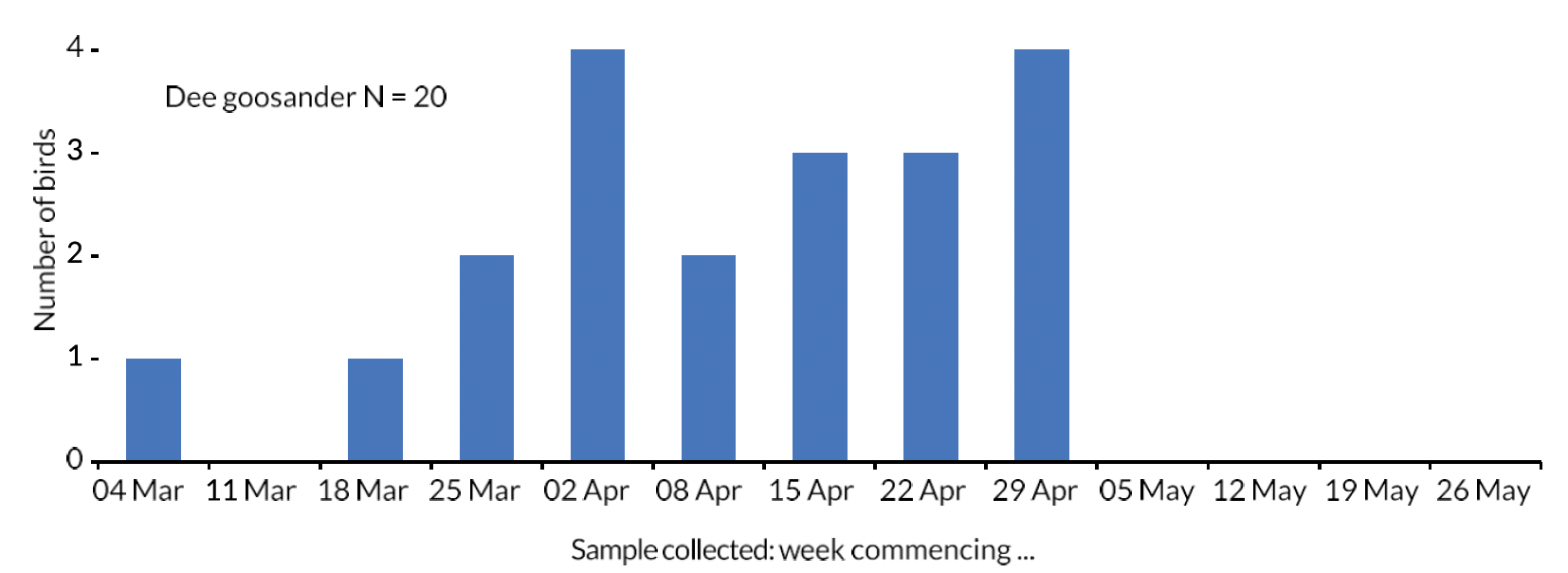
The R. Dee 2019 smolt run period Goosanders were sampled from seven beats, most birds (15/20 = 75%) coming from just three of these: Lower Crathes, Sluie, and Woodend. Apart from the Polmonier bird, all Goosanders were sampled on the stretch between Banchory and Aboyne (Table AP3.1).
| Beat | Goosanders sampled | |
|---|---|---|
| No. | (%) | |
| Lower Crathes | 8 | 40 |
| Woodend | 3 | 15 |
| Cattie Burn/Commonty | 1 | 5 |
| Borrowston/Sands Pool | 1 | 5 |
| Sluie | 4 | 20 |
| Dess | 2 | 10 |
| Polmonier, Crathie | 1 | 5 |
| Total | 20 | - |
(2a) R. Nith Goosanders (N = 15)
05 April - Buccleuch
16 April - Cowhill
16 April - Cleughfoot, Barjarg
18 April - Dalpeddar
18 April - Cowhill
24 April - Dalpeddar
24 April - Dalpeddar
24 April - Auldgirth
24 April - Cleughfoot, Barjarg
26 April - Blackwood
30 April - Blackwood
08 May - Buccleuch*
08 May - Buccleuch
08 May - Blackwood
22 May - Cleughfoot, Barjarg*
Most R. Nith 2019 'smolt run' Goosanders were sampled during a 4-week period from mid-April to the first week of May, except for single birds from the first week of April and from the third week of May (see Figure AP3.2).
The R. Nith 2019 'smolt run' Goosanders were sampled from six beats, 4 of these produced 3 (20%) birds each, a fifth produced two birds (13%), and the sixth a single bird (7%, Table AP3.2).

| Beat | Goosanders sampled | |
|---|---|---|
| No. | (%) | |
| Buccleuch | 3 | 20 |
| Cowhill | 2 | 13 |
| Cleughfoot/Barjarg | 3 | 20 |
| Dalpeddar | 3 | 20 |
| Auldgirth | 1 | 7 |
| Blackwood | 3 | 20 |
| Total | 15 | - |
(3a) R. Tweed Goosanders (N = 14)
03 April - Lower Floors
04 April - Lower Floors
12 April - Rutherford*
15 April - Lower Floors
15 April - Markestoun
16 April - Lower Floors
30 April - Lower Floors
30 April - The Lees
01 May - Lower Floors
03 May - Bemersyde
24 May - Lower Floors
25 May - Lower Floors*
29 May - Lower Floors
31 May - Lower Floors
The R. Tweed 2019 smolt run period, Goosanders were sampled in four periods: the first few days of April, the third week of April, the last week of April/first few days of May, and over the last two weeks of May (see Figure AP3.3).

The R. Tweed 2019 smolt run period Goosanders were sampled from five beats, most birds (10/14 = 71%) coming from just one of these (Lower Floors), and single birds coming from each of four others (Table AP3.3).
| Beat | Goosanders sampled | |
|---|---|---|
| No. | (%) | |
| The Lees | 1 | 7 |
| Lower Floors | 10 | 71 |
| Rutherford | 1 | 7 |
| Markerstoun | 1 | 7 |
| Bemersyde | 1 | 7 |
| Total | 14 | - |
(4a) R. Spey Goosanders (N = 15), 2019
08 March - Easter Echlies
26 March - Orn's Beat
01 April - Ballindalloch*
01 April - Ballindalloch
03 April - Tulchan D*
09 April - Ballindalloch
11 April - Tulchan B
11 April - Lower Pitchroy
11 April - Inverfiddich
13 April - Tulchan B
15 April - Lower Pitchroy
24 April - Ballindalloch
25 April - Castle Grant
25 April - Castle Grant
29 April - Castle Grant
The R. Spey 2019 smolt run period Goosanders were sampled during a 6-week period from the last week of March to the last week of April/first few days of May, except for a single bird from the first week of March (see Figure AP3.4).
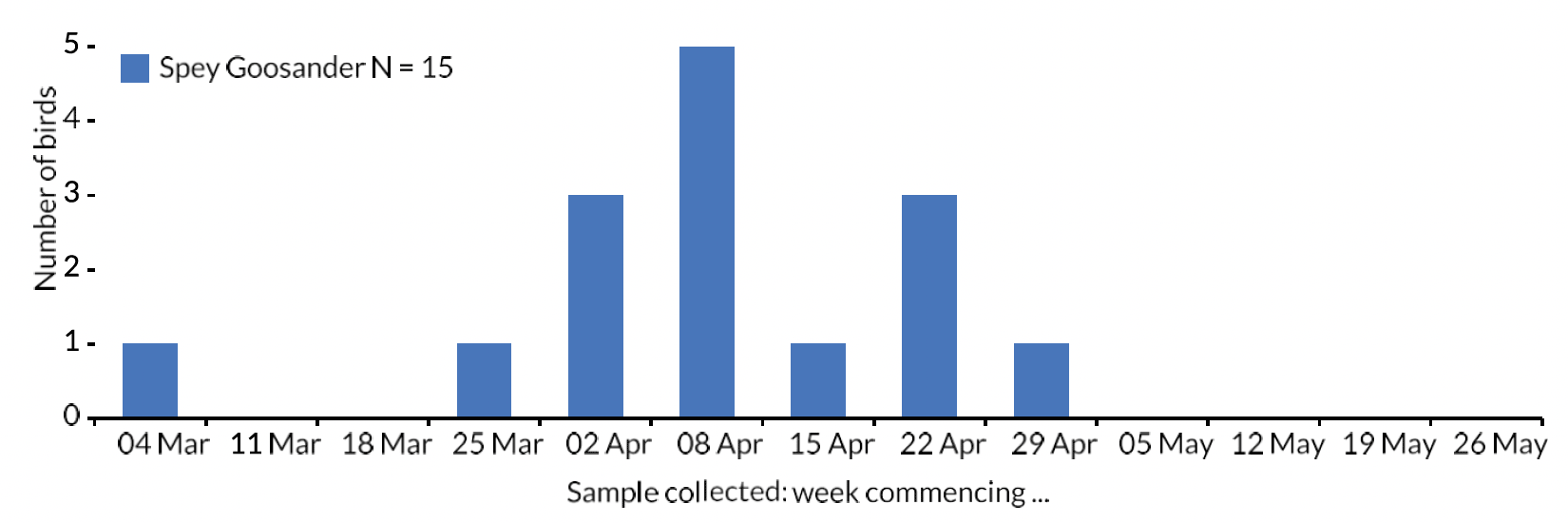
The R. Spey 2019 smolt run period Goosanders were sampled from seven beats, most birds (10/15 = 67%) coming from three of these, and 1-2 birds coming from each of four others (Table AP3.4).
| Beat | Goosanders sampled | |
|---|---|---|
| No. | (%) | |
| Easter Echlies | 1 | 7 |
| Orn's Beat | 1 | 7 |
| Balindalloch | 4 | 27 |
| Tulchan | 3 | 20 |
| Lower Pitchroy | 2 | 13 |
| Inverfiddich | 1 | 7 |
| Castle Grant | 3 | 20 |
| Total | 15 | - |
(5a) R. Dee Cormorants (None)
No Cormorants sampled from the R. Dee during the 2019 smolt run period.
(6a) R. Nith Cormorants (N= 6)
20 March - Cowhill*
20 March - Cowhill* … … likely regurgitated
04 April - Newhole, Buccleuch
05 April - Doctor's Pool, Buccleuch
11 April - Cowhill*
26 April - White Hill, Buccleuch
The R. Nith smolt run period Cormorants were sampled during the third week of March (2 birds), the first and second weeks of April (2 birds and a single, respectively), and another single bird during the penultimate week of April. These Cormorants were sampled from four beats, three birds from Cowhill and three each from a different stretches of Buccleuch water.
(7a) R. Tweed Cormorants (N = 9)
02 April - The Lees
11 April - Bemersyde
23 May - Rutherford*
23 May - Rutherford
24 May - Rutherford*
24 May - Rutherford
24 May - Rutherford
24 May - Rutherford
28 May - Rutherford*
Most (7/9 = 78%) of the R. Tweed smolt run period Cormorants were sampled during the last two weeks of May, with single birds collected five weeks earlier - in each of the first two weeks of April. These Cormorants were sampled from three beats, most birds (7/9 = 78%) coming from a single beat, with single birds collected in each of the two other beats.
(8a) R. Spey Cormorants (N = 1)
The single Cormorant sampled from the R. Spey during the smolt run period came from Kinchurdy during the first week of April.
In summary for the smolt run period 2019, Goosanders were sampled on the Dee over quite a protracted period of over seven weeks with 75% of birds coming from three beats (Lower Crathes, Sluie, Woodend). Those from the Nith were sampled mainly in a 4-week period, spread mostly across four beats (Blackwood, Buccleuch, Dalpeddar, Cleughfoot/Barjarg). Goosanders on the Tweed were sampled on separate weeks in April and the last fortnight in May, 71% of them from a single beat (Lower Floors). On the Spey, Goosanders were sampled over quite a protracted period of over six weeks from March - but concentrated in April - with 67% of birds coming from three beats (Balindalloch, Tulchan, Castle Grant). Nith Cormorants showed quite disparate sampling, from two beats/estates (Cowhill, Buccleuch) and most Cormorants from the Tweed were sampled on 3 days in May, 78% came from a single beat (Rutherford).
Overall, samples from the smolt run period appeared to either be spread over the season (Dee, Spey) or concentrated in a few weeks (Nith, Tweed). Very often, a large proportion of birds came from a relatively small number of beats. In general, samples during the smolt run period were dominated by Goosanders (full samples collected on all four rivers), with few Cormorants being collected (predominantly from the Tweed and Nith, although full samples were not collected on any of the rivers).
(b) Samples from the autumn-winter period, 2019/20
During the autumn winter 2019/20, Goosanders from the R. Dee were collected from Lower Crathes (including Greenbanks). Goosanders from the R. Nith came from Dalswinton, Blackwood, Boatford (including Kirkbog), Buccleuch, and Buccleuch (Mid) (including Whitehill). Goosanders from the R. Tweed were sampled from the Lees, Hendersyde, Lower Floors, Markestoun (Upper and Lower), Middle Mertoun, and Bemersyde. Those from the R. Spey were sampled at Low Water (Groynes), Arndilly, Easter Elchies, Pitchroy, and a single bird had no location provided.
Cormorants from the R. Dee were collected from only Lower Crathes. Cormorants from the R. Nith came from Cowhill, Blackwood, Boatford (Kirkbog), and Buccleuch (Mid) (Whitehill). Cormorants from the R. Tweed were sampled from Ladykirk, the Lees, Hendersyde, Lower Floors, Rutherford, Middle Mertoun, and Bemersyde. Those from the R. Spey were sampled at Brae Water (including Intake, Beat 5, Flats Pool), Delfur, Arndilly, Easter Elchies (including Inverfiddich), Knockando Tulchan (D), and Kinchurdy.
(1b) R. Dee Goosanders (N = 2)
22 Nov - Crathes, Greenbanks
25 Nov - Lower Crathes
On the R. Dee, only two Goosanders were sampled during the autumn-winter. These birds were collected over a 4-day period in late November and both came from the Crathes beat on the lower river.
(2b) R. Nith Goosanders (N = 10)
13 Oct - Blackwood
08 Nov - Whitehill, Buccleuch
08 Nov - Whitehill, Buccleuch
15 Nov - Dalswinton
20 Nov - Kirkbog
20 Nov - Boatford
22 Jan - Blackwood
28 Jan - Dalswinton
03 Feb - Blackwood
04 Feb - Buccleuch
On the R. Nith, only ten Goosanders were sampled during the autumn-winter in two main periods. The first was a 3-week period throughout November 2019, the second a 3-week period covering the last two weeks of January and the first week of February 2020. In addition, a single Goosander was sampled in the first half of October 2019 (Figure AP3.5).
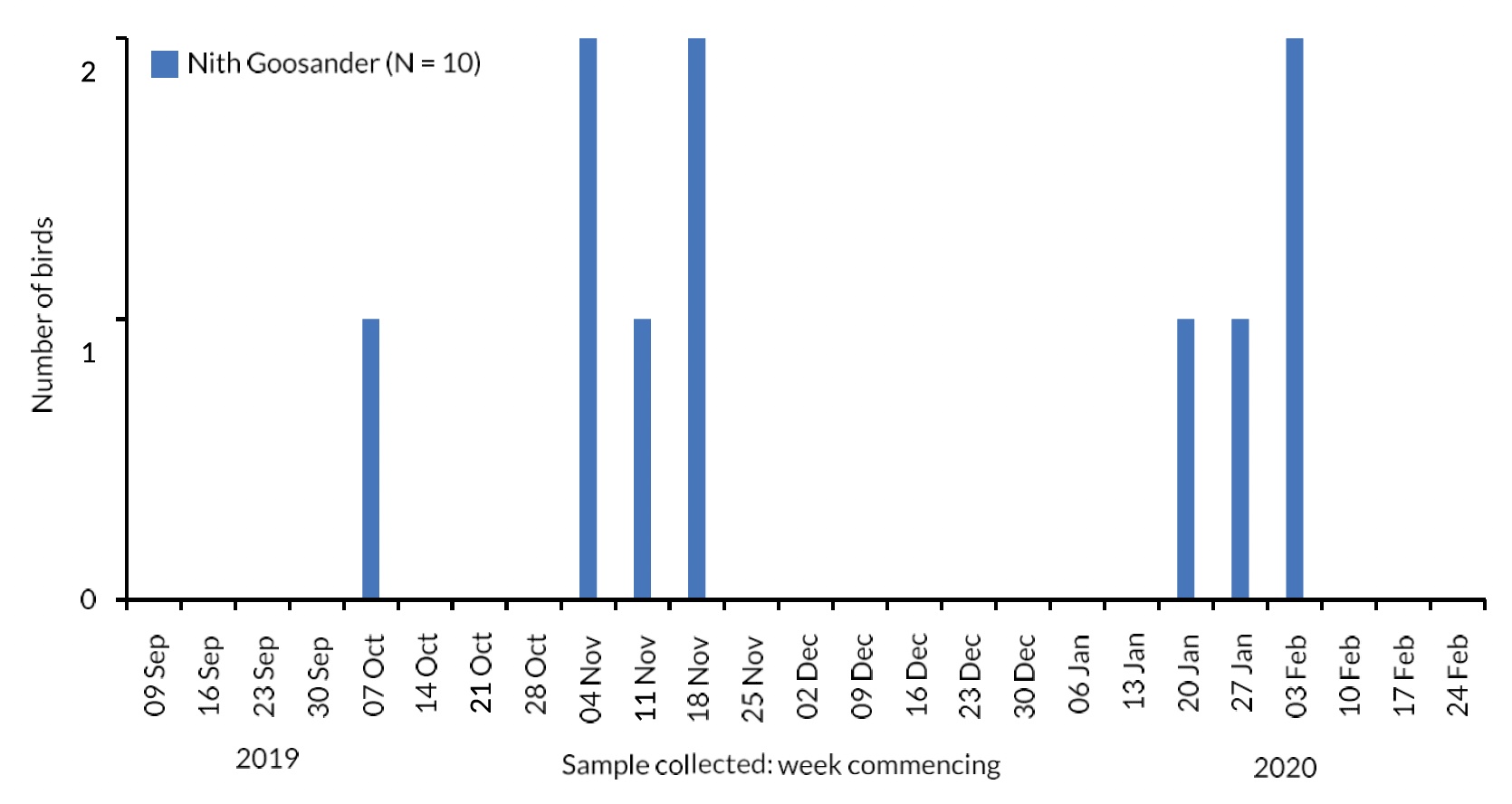
Goosanders from the R. Nith in autumn-winter were sampled from six beats, one of these produced three (30%) birds, two others produced two birds (20%) each, and the remaining three beats a single bird (10% each (Table AP3.5).
| Beat | Goosanders sampled | |
|---|---|---|
| No. | (%) | |
| Blackwood | 3 | 30 |
| Whitehill, Buccleuch | 2 | 20 |
| Dalswinton | 2 | 20 |
| Kirkbog | 1 | 10 |
| Boatford | 1 | 10 |
| Buccleuch | 1 | 10 |
| Total | 10 | - |
(3b) R. Tweed Goosanders (N = 24)
09 Sep - M. Mertoun
09 Sep - M. Mertoun
20 Sep - U. Markestoun
23 Sep - M. Mertoun
23 Sep - M. Mertoun
03 Oct - Hendersyde
04 Oct - Bemersyde
14 Oct - U. Markestoun
14 Oct - The Lees
17 Oct - U. Markestoun
22 Oct - L. Floors
24 Oct - L. Markestoun
25 Oct - L. Floors
05 Nov - L. Floors
06 Nov - Hendersyde
08 Nov - Hendersyde
09 Nov - L. Markestoun
10 Nov - Bemersyde
10 Nov - Bemersyde
11 Nov - Bemersyde
19 Nov - Bemersyde
20 Nov - Bemersyde
20 Nov - Bemersyde
28 Nov - L. Floors
On the R. Tweed, some 24 Goosanders were sampled in three periods during autumn 2019. Samples were taken throughout September and the first few days of October (29%), during the middle two weeks of October (25%), and throughout November (46%, Figure AP3.6).
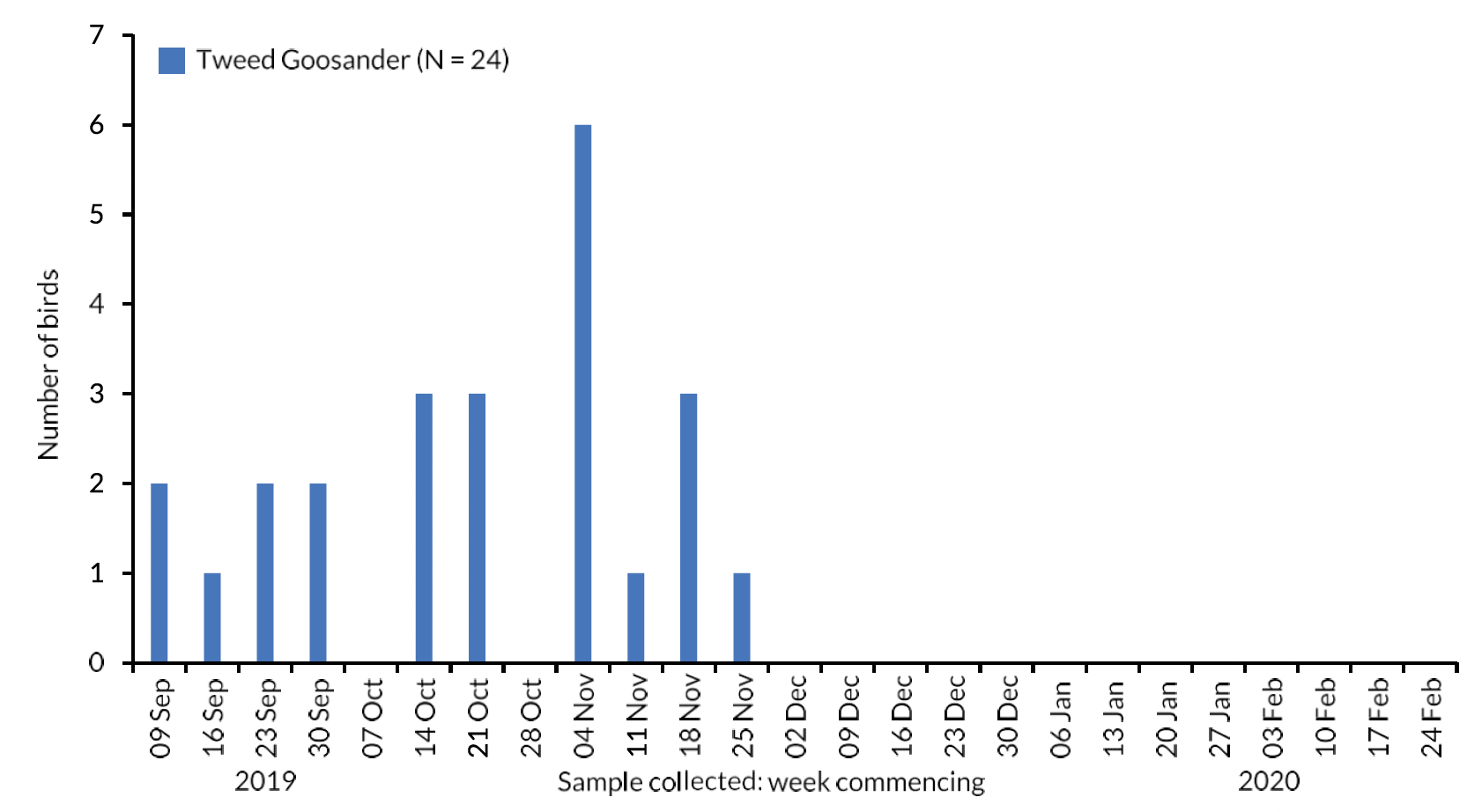
Goosanders from the R. Tweed in the autumn were sampled from seven beats. About a third of birds (29%) came from Bemersyde, and a fifth of them (20%) from Markestoun, and slightly fewer (17% each) from M. Mertoun and L. Floors. Three Goosanders came from Hendersyde, and a single one from Lees (Table AP3.6).
| Beat | Goosanders sampled | |
|---|---|---|
| No. | (%) | |
| M. Mertoun | 4 | 17 |
| U. Markestoun | 3 | 12 |
| Hendersyde | 3 | 12 |
| Bemersyde | 7 | 29 |
| The Lees | 1 | 4 |
| L. Floors | 4 | 17 |
| L. Markestoun | 2 | 8 |
| Total | 24 | - |
(4b) R. Spey Goosanders (N = 8)
11 Sep - Pitchroy
03 Oct - Arndilly
03 Oct - Arndilly
14 Oct - L. Pitchroy*
29 Nov - Arndilly
04 Dec - No location
18 Dec - East Elchies
19 Dec - Groynes
On the R. Spey, only eight Goosanders were sampled during the autumn-winter period. Birds came from the first half of September (single bird), the first half of October (three birds), the end of November and beginning of December (two birds), and the week before Christmas (two birds, Figure AP3.7).
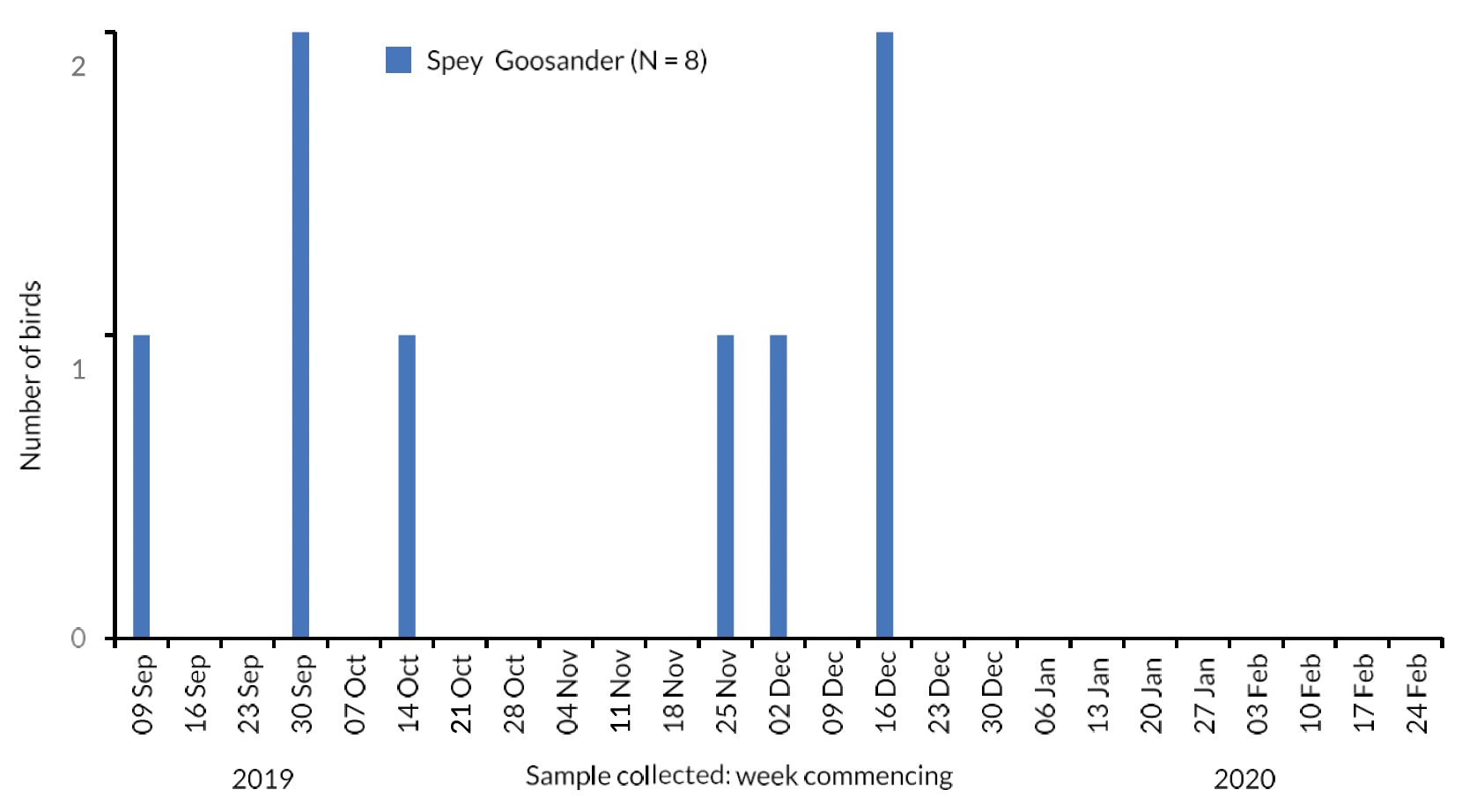
Goosanders from the R. Spey in autumn-winter were sampled from at least four beats (the location of one bird was not given). About a third of birds (38%) came from Arndilly, a quarter of them (20%) from Pitchroy, and single birds came from each of the remaining beats (Table AP3.7).
| Beat | Goosanders sampled | |
|---|---|---|
| No. | (%) | |
| Pitchroy | 2 | 25 |
| Arndilly | 3 | 38 |
| Easter Elchies | 1 | 12 |
| Groynes | 1 | 12 |
| No location given | 1 | 12 |
| Total | 8 | - |
(5b) R. Dee Cormorants (N = 4)
2 Dec - L. Crathes
3 Dec - L. Crathes*
05 Dec - L. Crathes
20 Jan - L. Crathes
Small numbers of R. Dee Cormorants were sampled in autumn-winter, most (three birds, 75%) in the first week of December 2019, and a fourth bird (25%) in the second half of January 2020. All birds came from the Crathes beat on the lower river.
(6b) R. Nith Cormorants (N = 12)
08 Nov - Kirkbog
12 Nov - Kirkbog
12 Nov - Kirkbog
15 Nov - Whitehill, Buccleuch
20 Nov - Boatford
21 Nov - Kirkbog
03 Dec - Kirkbog
19 Jan - Cowhill
19 Jan - Cowhill
23 Jan - Blackwood
28 Jan - Cowhill
13 Feb - Cowhill
On the R. Nith, 12 Cormorants were sampled during the autumn-winter, in two main periods. The first covered the first three weeks of November (6 birds, 50%) plus a single bird (8%) from the first week of December 2019, the second covered the last three weeks of January 2020 (4 birds, 33%) plus a single bird (8%) around mid-February 2020 (Figure AP3.8).
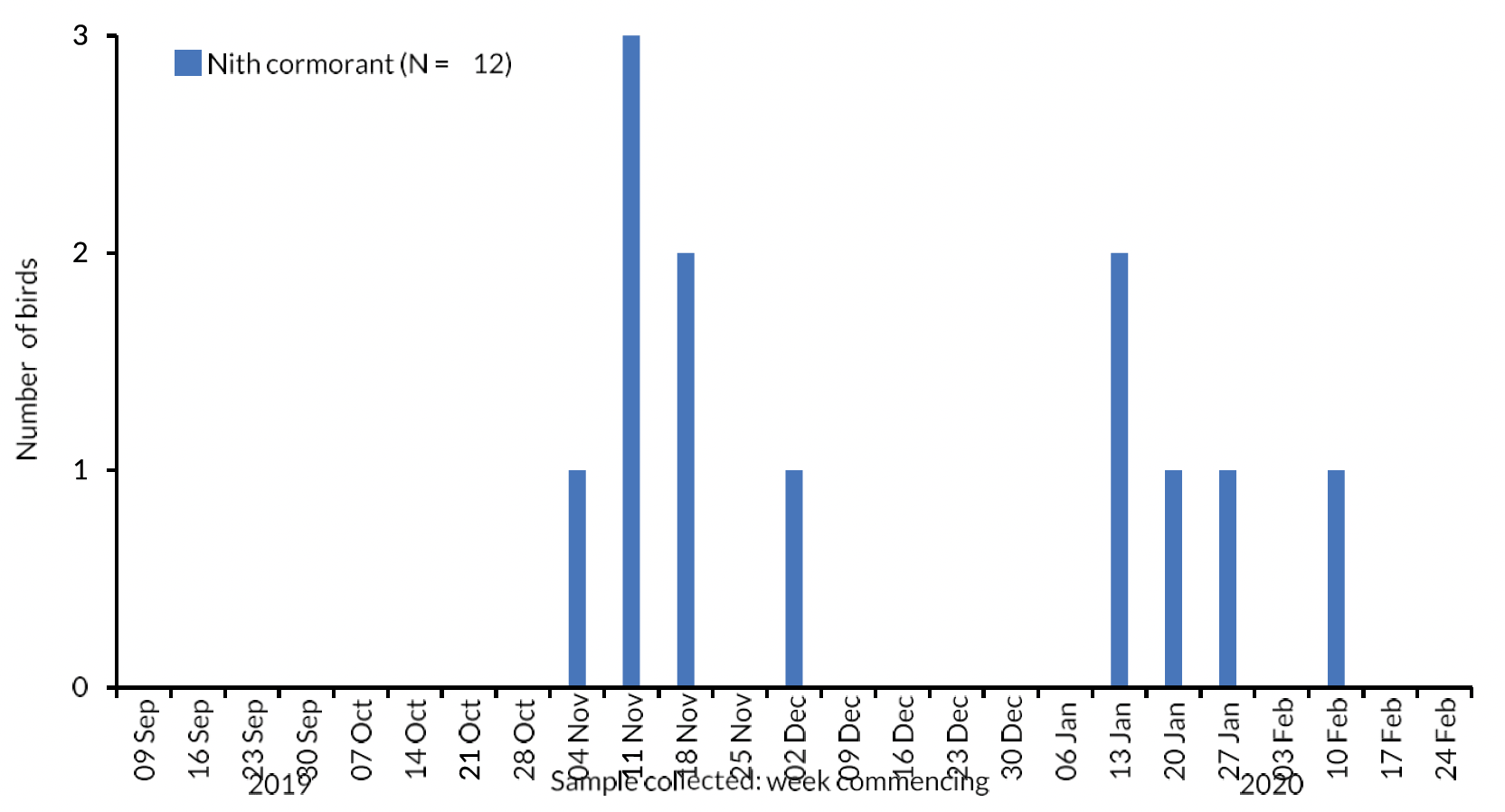
Cormorants from the R. Nith in autumn-winter were sampled from at least four beats. Just under half of birds (42%) came from Kirkbog, a third of them (33%) from Cowhill, two birds (16%) from Buccleuch, and a single one from Blackwood (Table AP3.8).
| Beat | Goosanders sampled | |
|---|---|---|
| No. | (%) | |
| Kirkbog | 5 | 42 |
| Whitehill, Buccleuch | 1 | 8 |
| Boatford | 1 | 8 |
| Cowhill | 4 | 33 |
| Blackwood | 1 | 8 |
| Total | 12 | - |
(7b) R. Tweed Cormorants (N = 27)
10 Sep - L. Floors
20 Sep - L. Floors
21 Sep - The Lees
23 Sep - Hendersyde
25 Sep - L. Foors
25 Sep - Rutherford
02 Oct - Lady Kirk
05 Oct - L. Floors
15 Oct - L. Floors*
15 Oct - M. Mertoun
20 Oct - Hendersyde
22 Oct - M. Mertoun
22 Oct - M. Mertoun
22 Oct - Rutherford
23 Oct - L. Floors
23 Oct - L. Floors
23 Oct - L. Floors
23 Oct - L. Floors*
24 Oct - L. Floors
24 Oct - L. Floors
25 Oct - L. Floors
31 Oct - The Lees
01 Nov - Rutherford
06 Nov - Bemersyde
19 Nov - Rutherford
19 Nov - Rutherford
19 Nov - Rutherford
On the R. Tweed, 27 Cormorants were sampled throughout autumn 2019. Most of these birds (16 birds, 59%) were sampled throughout October, and the remaining six birds (22%) in September (mostly toward the end of the month). A further five birds (19%) came from the first three weeks of November 2019 (Figure AP3.9).
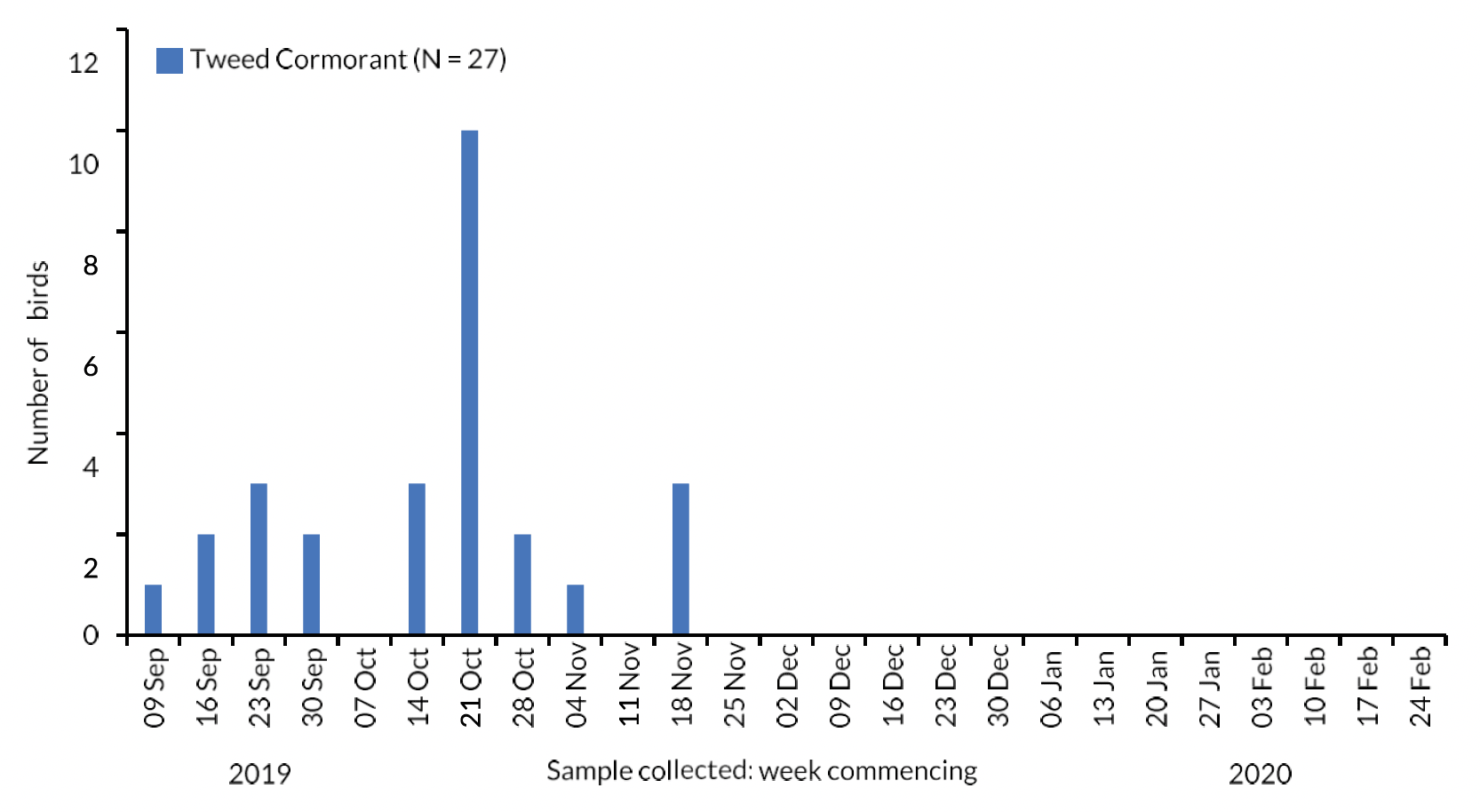
Cormorants from the R. Tweed in the autumn were sampled from seven beats. Just under half of the 27 birds (44%) came from L. Floors, and just under a quarter of them (22%) from Rutherford, three birds (11%) from M. Mertoun, two (7%) each from Lees and Hendersyde, and a single bird (4%) from Bemersyde (Table AP3.9).
| Beat | Goosanders sampled | |
|---|---|---|
| No. | (%) | |
| L. Floors | 12 | 44 |
| Lees | 2 | 7 |
| Hendersyde | 2 | 7 |
| Rutherford | 6 | 22 |
| Lady Kirk | 1 | 4 |
| M. Mertoun | 3 | 11 |
| Bemersyde | 1 | 4 |
| Total | 27 | - |
(8b) R. Spey Cormorants (N = 13)
04 Dec - Knockano*
04 Dec - Arndilly
05 Dec - Delfur
19 Dec - Intake
06 Jan - Arndilly*
07 Jan - Arndilly
14 Jan - Inverfiddich*
04 Feb - Tulchan D
04 Feb - Tulchan D
07 Feb - Beat 5*
13 Feb - Kinchurdy
13 Feb - Easter Elchies*
24 Feb - Flats Pool
On the R. Spey, Cormorants were sampled throughout the winter. Four birds (31%) were taken in the first three weeks of December 2019, three birds (23%) in the first half of January 2020, with most (6 birds, 46%) being sampled throughout February 2020 (Figure AP3.10).
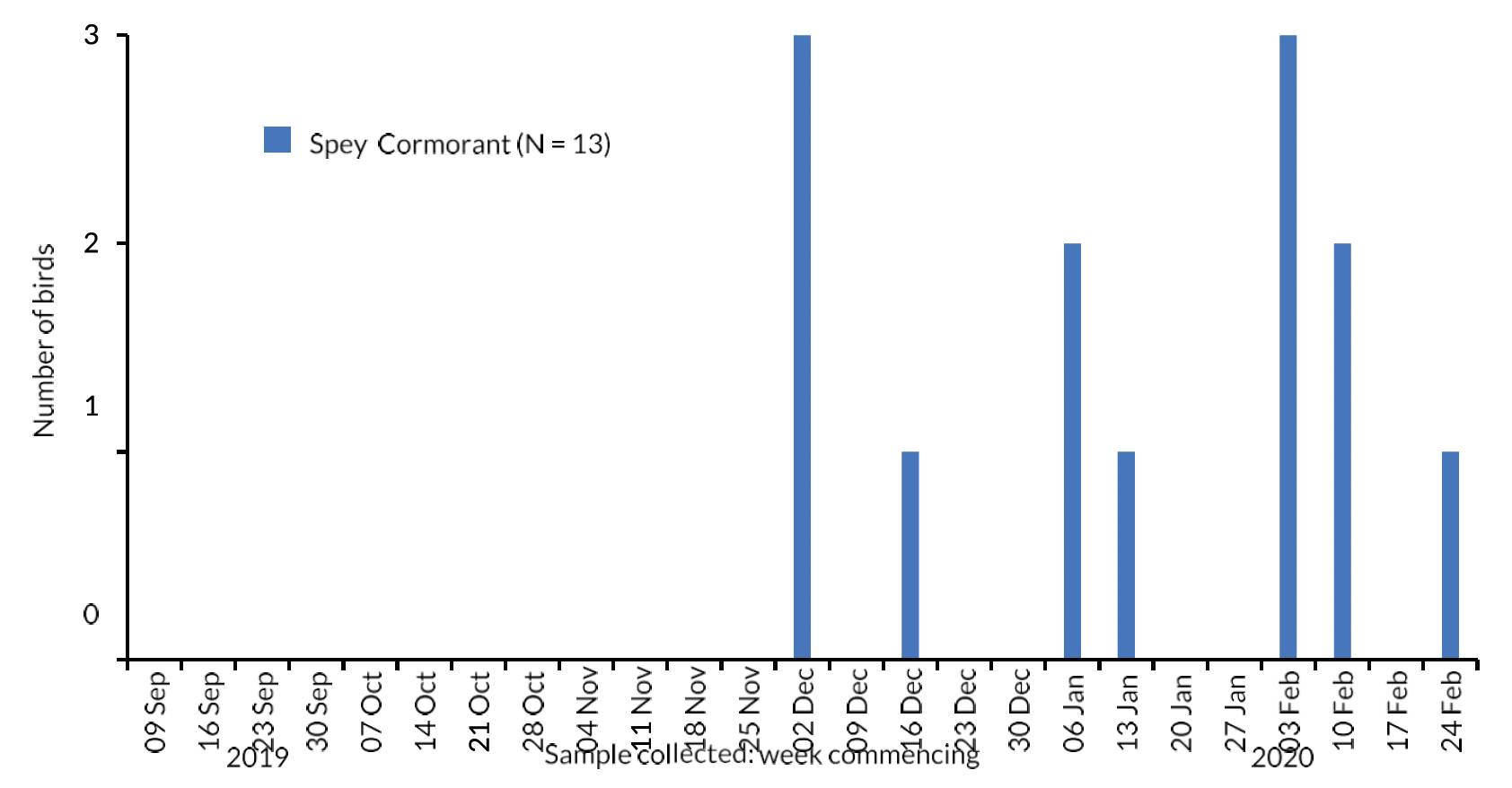
Cormorants from the R. Spey in the winter were sampled from ten beats. Three birds (23%) came from Delfur and two (15%) from Tulchan D. The remaining eight beats each provided a single bird (Table AP3.10).
| Beat | Goosanders sampled | |
|---|---|---|
| No. | (%) | |
| Knockando | 1 | 8 |
| Arndilly | 3 | 23 |
| Delfur | 1 | 8 |
| Intake | 1 | 8 |
| Inverfiddich | 1 | 8 |
| Tulchan D | 2 | 15 |
| Beat 5 | 1 | 8 |
| Kinchurdy | 1 | 8 |
| Easter Elchies | 1 | 8 |
| Flats Pool | 1 | 8 |
| Total | 13 | - |
In summary for the autumn-winter 2019/20 period, only two Goosanders were sampled on the Dee, both in the autumn in last ten days of November on the lower river (Greenbanks and Lower Crathes). Those from the Nith were also a small sample (10 birds) sampled in two three-week periods throughout the autumn-winter: the first in November and the second between the end of January and first week in February. Samples were collected from up to six beats, but mostly from Blackwood, Whitehill Buccleuch, and Dalswinton). A full sample of Goosanders (n = 24) from the Tweed were sampled in three periods during the autumn: throughout September and the first few days of October, during the middle two weeks of October, and throughout November. Samples came from seven beats, but most came from Bemersyde, Lower Floors, and M Mertoun). On the Spey, only a small number of Goosanders (n = 8) were sampled over quite a protracted period during the autumn-winter: 1-2 birds being shot a week during six weeks between September and December. Birds came from at least four beats, with most (N = 5) from Arndilly and Pitchroy.
Small numbers of Cormorants (N = 4) were sampled on the Dee in the winter, three in the first week of December and the fourth in late January. All birds came from a single beat (Lower Crathes) in the lower river. A full sample of Nith Cormorants (N = 12) was collected in two main periods throughout the autumn-winter: seven birds from Kirkbog and Buccleuch throughout November and the first few days of December, and five birds from Cowhill and Blackwood from mid-January to mid-February. There was a large sample of Cormorants (N = 27) from the Tweed, all sampled in the autumn. Several birds were sampled throughout September and the first three weeks of November, but the majority were collected throughout October. Cormorants were sampled on seven Tweed beats but over three-quarters of the Cormorants came from Lower Floors, Rutherford, and M. Mertoun. A full sample of Cormorants (N = 13) was collected on the Spey in the winter with several birds in December, a few in January, and the largest number in February. Sampling appeared to be relatively widespread compared to the other rivers, with small numbers of birds (no more than three) coming from ten Nith beats.
Overall, samples from the autumn-winter period appeared to either be spread over the sampling period (Nith, Spey) or sampled in the autumn (Tweed). Very often, a large proportion of birds came from a relatively small number of beats. In general, the autumn-winter samples of Goosanders were small on all rivers except the Tweed, and considerably more Cormorants were sampled in the autumn-winter period than were in the preceding smolt run period. Full samples of Cormorants were collected on all rivers except the Dee, although those on the Spey were compromised by a high proportion (42%) of empty stomachs without food.
Contact
There is a problem
Thanks for your feedback